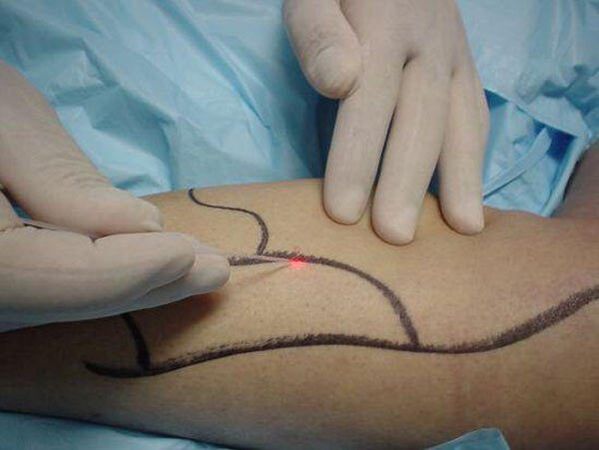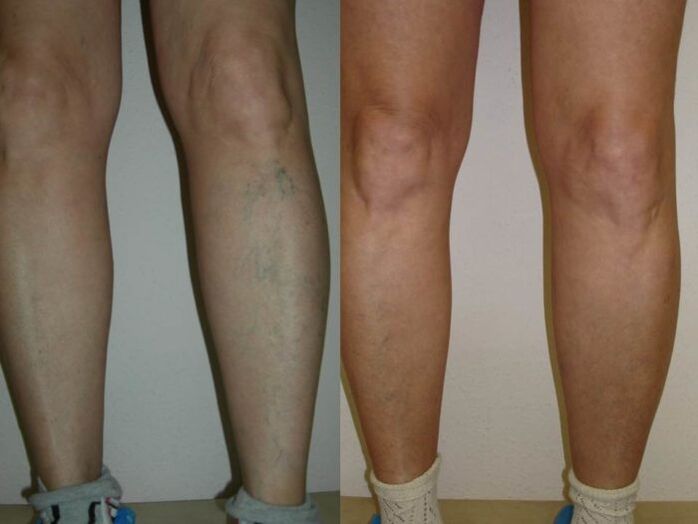Varicose veins in the legs are a common pathology that occurs in people of different genders and ages, regardless of country of residence. For a long time, the only way to get rid of varicose veins in the lower extremities was surgery. But today doctors offer a painless and effective method - laser treatment of varicose veins.
The essence of the procedure is boiling until a special light guide is inserted into the veins, under the influence of which the damaged arteries will stick together and blood flow will be directed through healthy arteries. If we consider alternative treatments, then:
- Classical vascular removal (phlebectomy) is characterized by pain and trauma, there is a risk of infectious complications;
- Removal of only part of the patient's vessel (microflebectomy) leaves scars on the skin;
- Sclerotherapy sometimes causes allergies.
Given the listed disadvantages of laser, the best option is the laser treatment of varicose veins. Doctors have been using this method for more than 10 years, and during this time laser coagulation has not caused any complaints. Not everyone can afford it, but given the effectiveness of the procedure, it is quite possible to collect the required amount or take a loan.
Indications for laser coagulation
The procedure is indicated by the presence of dilated large and small saphenous veins. In addition, the expansion of the vascular bed should not exceed 1 cm, and the vessels themselves should be largely equal without sharp bends. The branches of the veins should be either healthy or slightly dilated. In other words, laser coagulation is effective in the early stages of varicose veins, when the severity is small, and this applies only to superficial veins. As for varicose veins larger than 1 cm, they can also be "glued" with a laser, but in the future there is a risk of re-adhesion of the vein and the failure of the entire treatment.

The laser operates in a small area, which eliminates the negative effects on adjacent tissues. For this reason, significant damage to blood vessels and laser effect for deep veins is not. In such cases, choose one of the classic methods listed above.
Contraindications to laser treatment
In addition to the cases listed above, endovasal laser coagulation of varicose veins is contraindicated in cases where the technique is ineffective, as it may harm the patient. There are enough contraindications, and they are all relative and absolute.
Relative ones only include contraindications that do not allow the operation to be performed at this time. This can be burns and inflammation of the skin, exacerbation of chronic pathologies. The existing problem needs to be treated, and then the removal of the veins with a laser should be continued. If you do the opposite, the risk of complications is high. Pregnancy and hepatitis B are also considered relative contraindications, because during this period the body weakens and the load on the legs is great. Due to the blockage of the vessels of the lower extremities, obese people do not have surgery - there is a possibility of complications.
Absolute ones include those contraindications, so it is forbidden to remove a person with a laser. These are the following states:
- damage to the walls of blood vessels;
- lymphatic and blood flow disorders in the legs;
- prone to thrombophlebitis and thrombosis.
Against the background of such conditions, the laser can cause venous thrombosis and damage blood vessels. Other contraindications are people's lifestyle - if in the future (after surgery) it is impossible to actively move and wear compression underwear, then the vessel may become inflamed and treatment will be ineffective.
How the procedure is performed
Laser treatment of varicose veins in the legs is carried out in an outpatient setting. General and local anesthesia is not necessary, because the affected area is very small and the process takes place inside the blood vessel. If necessary, if you are afraid of surgery, you can take sedatives on the advice of a doctor. The essence of the procedure:
- A small incision is made in the skin of the foot, through which a light guide is inserted into the damaged vein. This device will emit laser light at a controlled wavelength;
- blood is pushed through a damaged vessel due to radiation;
- Under the influence of the laser, the walls of the vessel stick together, the blood no longer circulates here.
Typically, laser treatment takes up to 90 minutes. Once the damaged arteries are sealed, blood is directed through deep veins located inside the muscles. There are no scars or hematomas after such a procedure.
Benefits of laser therapy
As mentioned at the beginning of the article, laser removal of varicose veins has many advantages over other methods. Everyone should know about the main advantages:
- there is no need to go to the hospital, because the procedure is performed in an outpatient setting, you can go home the same day;
- The procedure gives the best cosmetic effect, because the doctor reaches the affected vein through a small puncture in the skin, which will then heal without wounds and scars;
- Modern laser equipment scatters radiation well, which allows for high-quality treatment inside the vessel. This eliminates the risk of bleeding and bruising;
- it is possible to remove the veins of both legs immediately;
- The rehabilitation period passes very quickly and painlessly. You can go home an hour after the procedure and live the same life in a few days.

Given the listed advantages of the procedure, it is clear why the treatment of varicose veins using laser coagulation is the most effective and safe. After that, there are no thrombophlebitis and secondary infection, scars and discomfort, complications and relapses.
Disadvantages of laser vein therapy
In addition to the advantages and disadvantages of any medical manipulation. While removing the veins in the legs, laser treatment is not always cloudless. Rather, you should be familiar with the possible difficulties and shortcomings of the technique before the procedure:
- severe varicose veins are not treated with laser;
- laser therapy with a large diameter of the damaged vessel is combined with surgery and can not do without cuts and scars on the skin;
- Laser treatment of varicose veins involves wearing compression stockings for at least one week after surgery, which is not to everyone's liking;
- The main drawback is the high cost of laser procedures by many.
After measuring the advantages and disadvantages mentioned, you can discuss with your doctor how to treat varicose veins in a particular situation.
Rehabilitation
There are no specific measures to restore health after laser coagulation of blood vessels. The patient quickly returns to normal exercise. No hospitalization is required as bed rest. The same can be said about antibiotics, physiotherapy procedures and tightly bandaged legs, such as mummy - a modern procedure is completely free of these shortcomings.
At the end of the operation, the doctor allows the patient to get up gradually. First you need to sit on the couch for a while to normalize your condition, after which you can get up. It is not recommended to get up sharply after lying on the couch for an hour, as this can lead to vascular collapse, dizziness, etc.
The patient does not feel pain in the legs when transferring their weight to them. The only thing that may bother you is a slight tingling sensation at the foot where the light guide is inserted. There is no need to take painkillers because there is no pain syndrome.

A prerequisite for the rehabilitation period will be the wearing of compression stockings. The duration of wearing such underwear and the degree of compression should be discussed individually with your doctor. Compression knitwear eliminates swelling and stops blood flow from the superficial vessels, the role of which is perceived by the deep blood vessels. Pre-purchased compression garments are placed directly on the patient's feet in the operating room after laser coagulation is complete.
For the first 2 days after the procedure, the compression stockings remain on the feet even at night, then are worn during the day and removed at night for the entire period recommended by the doctor. Considering that compression tights will warm the body, it is advisable to perform the procedure in the cold season. This way you can avoid unpleasant feelings and the need to wear tights on a hot day.
Physical activity is not limited - you can walk without help. With varicose veins and the only thing that should not be done after surgery is to lift weights. In the first week, it is not desirable to visit the sauna and steam room in the bath. In the future, you can safely walk long distances, drive a car and do your usual work.
Here are some general tips for anyone experiencing varicose veins in their legs:
- manage body weight because extra pounds are a burden on the spine, heart and blood vessels;
- Avoid static poses. If your professional activity involves sitting or standing for long periods of time, you should take breaks and warm up from time to time;
- you can't sit cross-legged - it narrows the blood vessels;
- need to quit smoking forever;
- shoes should be comfortable, women's heels - up to 5 cm in height;
- Normalize your daily routine by adding daily walks and regular gymnastics.
By following these tips, you can prolong the effect of the operation for a long time.













































